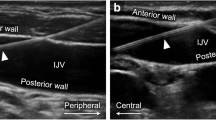Abstract
Objective: To determine whether ultrasound guidance can help operators to improve the results of jugular vein access in the ICU. Design: Prospective, randomized study. Setting: General Intensive Care Unit of a University Hospital. Patients: Seven-nine patients were assigned to internal jugular vein cannulation using anatomical landmarks alone (control group, n = 42) or with ultrasound guidance (ultrasound group, n = 37). Intervention: All cannulations were performed by junior house staff under the direct supervision of a senior physician. In the ultrasound group, an ultrasonography (7.5 MHz) was used and the transducer was covered by a sterile sheath. The placement and direction of the cannulating needle were determined on the ultrasound image. Measurements and results: Internal jugular vein cannulation was successful in 37/37 (100 %) patients in the ultrasound group and in 32/42 patients (76 %) in the control group (p < 0.01). Average access time was longer in the control group (235 ± 408 s vs 95 ± 174 s, p = 0.06) and carotid artery puncture occurred in five patients in each group (p = 0.83). Jugular cannulation was successful at the first attempt in 26 % in the control group and 43 % in the ultrasound group (p = 0.11). Thirty-two patients (86 %) in the ultrasound group and 23 patients (55 %) in the control group (p < 0.05) were cannulated within 3 min. The cannula could therefore not be inserted within 3 min in 19 patients (45 %) in the control group. Failure was explained by thrombosis (n = 1), small caliber of the internal jugular vein (< 5 mm, n = 3), abnormal vascular relations (n = 3). Among the ten primary failures of cannulation, an internal jugular vein catheter was able to be inserted in four cases by an experienced physician on the side initially selected and with ultrasound guidance in two cases. The catheter was inserted into the contralateral internal jugular vein under ultrasound guidance in the remaining four cases. Conclusion: Ultrasound guidance improved the success rate of jugular vein cannulation in ICU patients. Our results suggest that ultrasound guidance should be used when the internal jugular vein has not been successfully cannulated within 3 min by the external landmark-guided technique.
Similar content being viewed by others
Author information
Authors and Affiliations
Additional information
Received: 4 November 1996 Accepted: 22 May 1997
Rights and permissions
About this article
Cite this article
Slama, M., Novara, A., Safavian, A. et al. Improvement of internal jugular vein cannulation using an ultrasound-guided technique. Intensive Care Med 23, 916–919 (1997). https://doi.org/10.1007/s001340050432
Issue Date:
DOI: https://doi.org/10.1007/s001340050432




